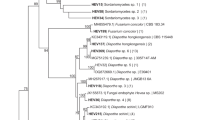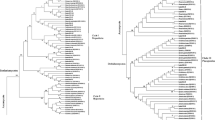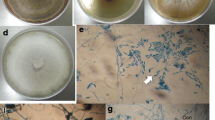Abstract
Endophytes are fungi and bacteria that inhabit plant tissues without causing disease. Endophytes have characteristics that are important for the health of the plant and have been isolated from several plants of economic and medicinal interest but rarely from ornamental plants. The current study isolates and identifies endophytic fungi from the leaves of Pachystachys lutea and evaluates the antagonistic activity of these endophytes as well as cellulase production by the endophytes. Fungi were isolated by fragmentation from surface-disinfected leaves and were identified by the sequencing of the ITS gene and the genes coding for EF 1-α and β-tubulin followed by multilocus sequence analysis. Molecular taxonomic analysis revealed that 78% of the identified fungi belonged to the genus Diaporthe. We also identified strains belonging to the genera Colletotrichum, Phyllosticta, Xylaria, Nemania, and Alternaria. Most of the strains tested were able to inhibit the growth of pathogenic fungi, especially PL09 (Diaporthe sp.), which inhibited the growth of Colletotrichum sp., and PL03 (Diaporthe sp.), which inhibited the growth of Fusarium oxysporum. The production of cellulase ranged from 0.87 to 1.60 μmol/min. Foliar endophytic fungal isolates from P. lutea showed promising results for the in vitro control of plant pathogens and for cellulase production. This paper is the first report on culturable endophytic fungi isolated from the ornamental plant P. lutea.
Similar content being viewed by others
References
Almeida TT, Orlandelli RC, Azevedo JL, Pamphile JA (2015) Molecular characterization of the endophytic fungal community associated with Eichhornia azurea (Kunth) and Eichhornia crassipes (Mart.) (Pontederiaceae) native to the Upper Parana River floodplain, Brazil. Genet Mol Res 14(2):4920–4931. https://doi.org/10.4238/2015.May.11.25
Aly AH, Debbab A, Proksch P (2011) Fungal endophytes: unique plant inhabitants with great promises. Appl Microbiol Biotechnol 90(6):1829–1845. https://doi.org/10.1007/s00253-011-3270-y
Arnold AE (2007) Understanding the diversity of foliar endophytic fungi: progress, challenges, and frontiers. Fungal Biol 21:51–66. https://doi.org/10.1016/j.fbr.2007.05.003
Badalyan SM, Innocenti G, Garibyan NG (2002) Antagonistic activity of xylotrophic mushrooms against pathogenic fungi of cereals in dual culture. Phytopathol Mediterr 41:200–225
Bayman P, Lebro LL, Tremblay RL, Lodge DJ (1997) Variation in endophytic fungi from roots and leaves of Lepenthes (Orchidaceae). New Phytol 135:143–149
Bogner CW, Kariuki GM, Elashry A, Sichtermann G, Buch AK, Mishra B, Thines M, Grundler FMW, Schouten A (2016) Fungal root endophytes of tomato from Kenya and their nematode biocontrol potential. Mycol Progress 15:30. https://doi.org/10.1007/s11557-016-1169-9
Brum MCP, Araújo WL, Maki CS, Azevedo JL (2012) Endophytic fungi from Vitis labrusca L. (Niagara Rosada) and its potential for the biological control of Fusarium oxysporum. Genet Mol Res 11(4):4187–4197. https://doi.org/10.4238/2012
Campanile G, Ruscelli A, Luisi N (2007) Antagonistc activity of endophytic fungi towards Diplodia corticola assessed by in vitro and in planta test. Eur J Plant Pathol 117:237–246. https://doi.org/10.1007/s10658-006-9089-1
Castellani A (1967) Maintenance and cultivation of common pathogenic fungi in distilled water. J Trop Med Hyg 42:181–184
Chandra S (2012) Endophytic fungi: novel sources of anticancer lead molecules. Appl Microbiol Biotechnol 95:47–59. https://doi.org/10.1007/s00253-012-4128-7
Corrêa RCG, Rhoden SA, Mota TR, Azevedo JL, Pamphile JA, Souza CGM et al (2014) Endophytic fungi: expanding the arsenal of industrial enzyme producers. J Ind Microbiol Biotechnol 41(10):1467–1478. https://doi.org/10.1007/s10295-014-1496-2
Fan X, Yang R, Qiu S, Cai X, Zou H, Hu F (2016) The endo-β-1,4-glucanase of Bacillus amyloliquefaciens Is required for optimum endophytic colonization of plants. J Microbiol Biotechnol 26(5):946–952. https://doi.org/10.4014/jmb.1512.12055
Felber AC, Orlandelli RC, Rhoden SA, Garcia A, Costa AT, Azevedo JL et al (2015) Bioprospecting foliar endophytic fungi of Vitis labrusca Linnaeus, Bordô and Concord cv. Ann Microbiol 66:765–775. https://doi.org/10.1007/s13213-015-1162-6
Ferreira DF (2008) SISVAR: um programa para análise e ensino de estatística. Rev Científica Symp 6:36–41
Ferreira MC, Cantrell CL, Wedge DE, Gonçalves VN, Jacob MR, Khan S et al (2017) Diversity of the endophytic fungi associated with the ancient and narrowly endemic neotropical plant Vellozia gigantean from the endangered Brazilian rupestrian grasslands. Biochem Syst Ecol 71:163–169. https://doi.org/10.1016/j.bse.2017.02.006
Fouda AH, Hassan SE, Eid AM, Ewais EE (2015) Biotechnological applications of fungal endophytes associated with medicinal plant Asclepias sinaica (Bioss.). Ann Agric Sci 60:95–104. https://doi.org/10.1016/j.aoas.2015.04.001
Gao F, Dai C, Liu X (2010) Mechanisms of fungal endophytes in plant protection against pathogens. Afr J Microbiol Res 4(13):1346–1351
Garcia A, Rhoden SA, Rubin Filho CJ, Nakamura CV, Pamphile JA (2012) Diversity of foliar endophytic fungi from the medicinal plant Sapindus saponaria L. and their localization by scanning electron microscopy. Biol Res 45:139–148. https://doi.org/10.4067/S0716-97602012000200006
Ghose TK (1987) Measurement of cellulase activities. Pure Appl Chem 59:257–268
Gomes RR, Glienke C, Videira SIR, Lombard L, Groenewald JZ, Crous PW (2013) Diaporthe: a genus of endophytic, saprobic and plant pathogenic fungi. Persoonia 31:1–41. https://doi.org/10.3767/003158513X666844
Gonzaga LL, Costa LE, Santos TT, Araujo EF, Queiroz MV (2014) Endophytic fungi from the genus Colletotrichum are abundant in the Phaseolus vulgaris and have high genetic diversity. J Appl Microbiol 118:485–496. https://doi.org/10.1111/jam.12696
Gutiérrez-Rojas I, Moreno-Sarmientoa N, Montoya D (2015) Mecanismos y regulación de la hidrólisis enzimática de celulosa en hongos filamentosos: casos clásicos y nuevos modelos. Rev Iberoam Micol 32:1–12. https://doi.org/10.1016/j.riam.2013.10.009
Han JH, Chon JK, Ahn JH, Choi IY, Lee YH, Kim KS (2016) Whole genome sequence and genome annotation of Colletotrichum acutatum, causal agent of anthracnose in pepper plants in South Korea. Genom Data 8:45–46. https://doi.org/10.1016/j.gdata.2016.03.007
Heydari A, Pessarakli M (2010) A review on biological control of fungal plant pathogens using microbial antagonists. J Biol Sci 10:273–290. https://doi.org/10.3923/jbs.2010.273.290
Katoh K, Toh H (2008) Recent developments in the MAFFT multiple sequence alignment program. Brief Bioinform 9(4):286–298. https://doi.org/10.1093/bib/bbn013
Leite TS, Cnossen-Fassoni A, Pereira OL, Mizubuti ESG, Araujo EF, Queiroz MV (2013) Novel and highly diverse fungal endophytes in soybean revealed by the consortium of two different techniques. J Microbiol 51:56–69. https://doi.org/10.1007/s12275-013-2356-x
Li G, Kusari S, Kusari P, Kayser O, Spiteller M (2015) Endophytic Diaporthe sp. LG23 produces a potent antibacterial tetracyclic triterpenoid. J Nat Prod 78(8):2128 – 2132. https://doi.org/10.1021/acs.jnatprod.5b00170
McGovern RJ (2015) Management of tomato diseases caused by Fusarium oxysporum. Crop Prot 73:78–92. https://doi.org/10.1016/j.cropro.2015.02.021
Miller GL (1959) Use of dinitrosalicylic acid reagent for determination of reducing sugar. Anal Chem 31:426–428. https://doi.org/10.1021/ac60147a030
Nylander JAA (2004) MrModeltest v2. Program distributed by the author. Evolutionary Biology Centre, Uppsala University, Uppsala
Onofre SB, Mattiello SP, Silva GC, Groth D, Malagi I (2013) Production of cellulases by the endophytic fungus Fusarium oxysporum.. Journal of Microbiology Research 3(4):131–134. https://doi.org/10.5923/j.microbiology.20130304.01
Orlandelli RC, Almeida TT, Alberto RN, Polonio JC, Azevedo JL, Pamphile J (2015) Antifungal and proteolytic activities of endophytic fungi isolated from Piper hispidum Sw. Braz J Microbiol 46(2):359–366. https://doi.org/10.1590/S1517-838246220131042
Pal A, Paul AK (2013) Bacterial endophytes of the medicinal herb Hygrophila spinosa T. Anders and their antimicrobial activity. Br J Pharm Res 3:795–806
Pamphile JA, Azevedo JL (2002) Molecular characterization of endophytic strains of Fusarium verticillioides (= Fusarium moniliforme) from maize (Zea mays. L). World J Microb Biotechnol 18:391–396. https://doi.org/10.1023/A:1015507008786
Panka D, Piesik D, Jeske M, Baturo-Ciesniewska A (2013) Production of phenolics and the emission of volatile organic compounds by perennial ryegrass (Lolium perenne L.)/Neotyphodium lolii association as a response to infection by Fusarium poae. J Plant Physiol 170(11):1010–1019. https://doi.org/10.1016/j.jplph.2013.02.009
Paulsen E, Andersen SL, Andersen KE (2009) Occupational contact dermatitis from golden shrimp plant (Pachystachys lutea). Contact Dermatitis 60(5):293–294. https://doi.org/10.1111/j.1600-0536.2009.01531.x
Polonio JC, Almeida TT, Garcia A, Mariucci GE, Azevedo JL, Rhoden SA et al (2015) Biotechnological prospecting of foliar endophytic fungi of guaco (Mikania glomerata Spreng.) with antibacterial and antagonistic activity against phytopathogens. Genet Mol Res 14(3):7297–7309. https://doi.org/10.4238/2015.July.3.5
Polonio JC, Ribeiro MAS, Rhoden SA, Sarragiotto MH, Azevedo JL, Pamphile JA (2016) 3-Nitropropionic acid production by the endophytic Diaporthe citri: Molecular taxonomy, chemical characterization, and quantification under pH variation. Fungal Biol 120:1600–1608. https://doi.org/10.1016/j.funbio.2016.08.006
Porras-Alfaro A, Bayman P (2011) Hidden fungi, emergent properties: endophytes and microbiomes. Annu Rev Phytopathol 49:291–315. https://doi.org/10.1146/annurev-phyto-080508-081831
Prada H, Ávila L, Sierra R, Bernal A, Restrepo S (2009) Caracterización morfológica y molecular del antagonismo entre el endofito Diaporthe sp. aislado de frailejón (Espeletia sp.) y el fitopatógeno Phytophthora infestans. Rev Iberoam Micol 26:198–201. https://doi.org/10.1016/j.riam.2009.01.002
Rambaut A (2009) FigTree v1. 3.1: Tree figure drawing tool. http://tree.bio.ed.ac.uk/software/figtree
Rhoden SA, Garcia A, Rubin Filho CJ, Azevedo JL, Pamphile JA (2012) Phylogenetic diversity of endophytic leaf fungus isolates from the medicinal tree Trichilia elegans (Meliaceae). Genet Mol Res 11(3):2513–2522. https://doi.org/10.4238/2012.June.15.8
Romeralo C, Santamaria O, Pando V, Diez JJ (2015) Fungal endophytes reduce necrosis length produced by Gremmeniella abietina in Pinus halepensis seedlings. Biol Control 80:30–39. https://doi.org/10.1016/j.biocontrol.2014.09.010
Ronquist F, Teslenko M, Van Der Mark P, Ayres DL, Darling A, Höhna S, Huelsenbeck JP (2012) MrBayes 3.2: efficient Bayesian phylogenetic inference and model choice across a large model space. Syst Biol 61(3):539–542. https://doi.org/10.1093/sysbio/sys029
Rubini MR, Silva-Ribeiro RT, Pomella AWV, Maki CS, Araujo WL, Santos DR, Azevedo JL (2005) Diversity of endophytic fungal community of cacao (Theobroma cacao L.) and biological control of Crinipellis perniciosa, causal agent of Witches’ Broom Disease. Int J Biol Sci 1:24–33
Santos TT, Leite TS, Queiroz CB, Araújo EF, Pereira OL, Queiroz MV (2016) High genetic variability in endophytic fungi from the genus Diaporthe isolated from common bean (Phaseolus vulgaris L.). J Appl Microbiol 120:388–401. https://doi.org/10.1111/jam.12985
Santoyoa G, Moreno-Hagelsieb G, Orozco-Mosqueda MC, Glick BR (2016) Plant growth-promoting bacterial endophytes. Microbiol Res 183:92–99. https://doi.org/10.1016/j.micres.2015.11.008
Souza HQ, Oliveira LA, Andrade JS (2008) Seleção de Basidiomycetes da Amazônia para produção de enzimas de interesse biotecnológico. Ciência Tecnol Alimentos 28:116–124
Specian V, Sarragiotto MH, Pamphile JA, Clemente E (2012) Chemical characterization of bioactive compounds from the endophytic fungus Diaporthe helianthi isolated from Luehea divaricata. Braz J Microbiol 43(3):1174–1182. https://doi.org/10.1590/S1517-838220120003000045
Tanney JB, McMullin DR, Green BD, Miller JD, Seifert KA (2016) Production of antifungal and antiinsectan metabolites by the Picea endophyte Diaporthe maritima sp. nov. Fungal Biol. https://doi.org/10.1016/j.funbio.2016.05.007
Tao G, Liu ZY, Hyde KD, Liu XZ, Yu ZN (2008) Whole rDNA analysis reveals novel and endophytic fungi in Bletilla ochracea (Orchidaceae). Fungal Divers 33:101–122
Terhonen E, Sipari N, Asiegbu FO (2016) Inhibition of phytopathogens by fungal root endophytes of Norway Spruce. Biol Control 99:53–63. https://doi.org/10.1016/j.biocontrol.2016.04.006
Vaidya G, Lohman DJ, Meier R (2011) SequenceMatrix: concatenation software for the fast assembly of multi-gene datasets with character set and codon information. Cladistics 27:171–180. https://doi.org/10.1111/j.1096-0031.2010.00329.x
Vaz AB, Mota RC, Bomfim MR, Vieira ML, Zani CL, Rosa CA et al (2009) Antimicrobial activity of endophytic fungi associated with Orchidaceae in Brazil. Can J Microbiol 55(12):1381–1391. https://doi.org/10.1139/W09-101
Vega FE, Simpkins A, Aime MC, Posada F, Peterson SW, Rehner SA, Infante F, Castillo A et al (2010) Fungal endophyte diversity in coffee plants from Colombia, Hawaii, Mexico and Puerto Rico. Fungal Ecol 3:122–138. https://doi.org/10.1016/j.funeco.2009.07.002
Wasshausen DC (1986) The systematics of the genus Pachystachys (Acanthaceae) Proc. Biol Soc Washington 99:162–163
Acknowledgements
The authors would like to thank CAPES (Coordenação de Aperfeiçoamento de Pessoal de Nível Superior) for the Master’s scholarship and CAPES/PNPD-UEM post-doctoral scholarship and CNPq—Conselho Nacional de Desenvolvimento Científico e Tecnológico—(311534/2014-7; 447265/2014-8) and the Fundação Araucária (276/2014) for financial support.
Author information
Authors and Affiliations
Corresponding author
Ethics declarations
Conflict of interest
The authors declare that they have no conflicts of interest.
Electronic supplementary material
Below is the link to the electronic supplementary material.
Rights and permissions
About this article
Cite this article
da Silva Ribeiro, A., Polonio, J.C., Costa, A.T. et al. Bioprospection of Culturable Endophytic Fungi Associated with the Ornamental Plant Pachystachys lutea. Curr Microbiol 75, 588–596 (2018). https://doi.org/10.1007/s00284-017-1421-9
Received:
Accepted:
Published:
Issue Date:
DOI: https://doi.org/10.1007/s00284-017-1421-9




